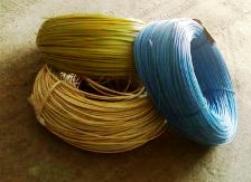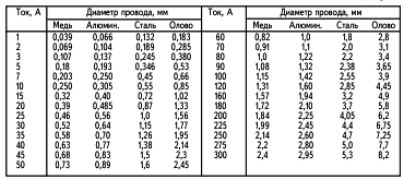Categories: Featured Articles » Electrician Secrets
Number of views: 89040
Comments on the article: 3
How to choose the right wires for wiring and make a fuse
 For the correct choice of wire cross-section, it is necessary to take into account the value of the maximum current consumed by the load. The current value is easy to determine, knowing the nameplate power of consumers according to the formula I= P / 220 (for example, for an electric heater with a power of 2000 W, the current will be 9 A, for a 60 W light bulb - 0.3 A).
For the correct choice of wire cross-section, it is necessary to take into account the value of the maximum current consumed by the load. The current value is easy to determine, knowing the nameplate power of consumers according to the formula I= P / 220 (for example, for an electric heater with a power of 2000 W, the current will be 9 A, for a 60 W light bulb - 0.3 A).
Knowing the total current of all consumers and taking into account the ratio of the allowable current load for the wire of the open load on the wire cross-section (for copper wire 10 A per 1 mm, for aluminum wire 8 A per 1 mm), you can choose a wire.
At performing hidden wiring (in a tube or in a wall) the values given must be multiplied by a correction factor of 0.8. It should be noted that open wiring is usually performed with a wire of at least 4 mm cross section2 based on sufficient mechanical strength.
When choosing a type of wire, you must also take into account the permissible insulation breakdown voltage (you cannot use wires for a telephone line for electrical wiring to a 220 V network voltage).
The above ratios are easy to remember and provide sufficient accuracy for domestic use of wires. If you need to know with greater accuracy the long-term permissible current load for copper wires and cables, then you can use Table 1.
When wiring the circuits, a common switch and fuses (fuse-links or electromechanical machines) must be installed at the input. The most common fuses in household networks.
When a fuse blows, you need to quickly replace it, but there is not always a spare for the desired current. In this case, a jumper ("bug") is often made from any wire that comes to hand. Over time, this is forgotten, and when overloaded, the wiring may light up.
To avoid this, it is convenient to use a simplified formula that will allow you to correctly make a fuse for any current with sufficient accuracy. For a single-core copper wire, the fuse protection current is determined by the simplified formula I = 80 (d3 / 1/2)
where d is the diameter of the wire, mm The calculation results for different types of wires are shown in the table.
Mikheev N.V.
The article was published in the journal "RA-Electric"
https://env.electricianexp.com/
P.S. The formula for calculating the current of the fuse fuse by the known wire diameter is fixed:

See also at bgv.electricianexp.com
:


